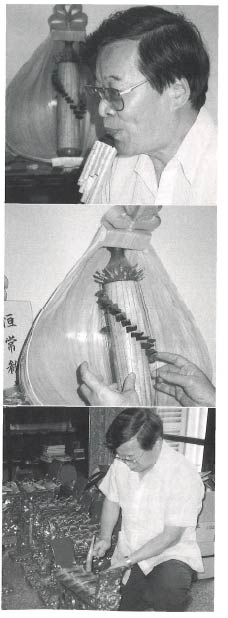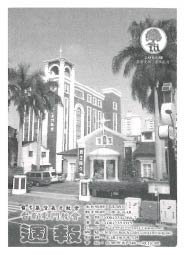I-to Loh and Pablo Sosa are highly respected authorities on congregational song, I-to Loh on Asian hymnody, and Pablo Sosa on songs from Latin America. We’re thrilled that both are planning to come to the 2003 Calvin Symposium on Worship and the Arts, and they’re looking forward to seeing each other again—previously they’ve worked together in international ecumenical conferences, including the World Council of Churches. Here is a brief introduction to both.
The Hymns of I-to Loh

I-to Loh was one of the speakers at the 2002 Conference of the World Association for Chinese Church Music (see "Learning with Brothers and Sisters Across the Globe"). After attending that conference in Taipei, I was able to spend a few days on the campus of Tainan Theological College and Seminary. There are many fascinating comparisons between the Tainan Seminary and Calvin Seminary, where I teach part time. They began the same year (1876), are situated in cities of similar size (although Tainan’s population covers probably one-quarter the land space of greater Grand Rapids), and the faculty and student body are similar in size. As president of the seminary, I-to Loh has made many efforts to develop the international character of the educational and worship life of the seminary.
I-to Loh’s father was a Presbyterian missionary to the indigenous peoples of Taiwan and also a hymnal editor, so from his youth, I-to was introduced to congregational singing in areas isolated from other cultures. I-to Loh lived most of his life in Taiwan under occupation; the Japanese occupation of 1895 to 1945 was replaced by another ruthless regime—the Chinese Nationalists (KMT) under Chiang Kai Shek when they retreated from mainland China to the island of Taiwan. In his forthcoming book on contemporary hymn writers, Michael Hawn relates the story of those years:
The militarily oppressive and culturally destructive occupation of Japan was replaced by martial law and the corrupt rule of the KMT. The martial law was not lifted until 1987. An event early in the occupation of the KMT, often referred to as the February Incident, set the tone for the forty years that followed. During the February 28 Incident in 1947 more than 20,000 Taiwanese were massacred by the Chinese Nationalists and disappeared without a trace.
No wonder I-to Loh is concerned with issues of justice in his hymns! Loh’s influence is felt around the world, and he has succeeded in drawing many guest professors to the seminary for extended stays. One is Carlton (“Sam”) Young, retired professor of church music from several United States colleges and seminaries. Young was editor of the last two editions of the United Methodist Hymnal. In fact, Young introduced me to I-to Loh in 1985—he invited me to join the Methodist hymnal committee meetings when I-to Loh was presenting Asian hymnody to the committee. That encounter was responsible for the few Asian hymns found in the 1987 Psalter Hymnal.
Sam and his wife Marge were my cohosts for the few days I spent at the seminary; they live across the walk from I-to Loh and his wife Hui-chin, a scholar in her own right with a passion for Christian education for youth. The Youngs have lived in Tainan one semester a year for the past five years while Sam teaches church music at the seminary. He has also donated his entire music library to the Tainan seminary.
Another guest at the seminary has been Shirley Erena Murray from New Zealand, author of many hymn texts in collections published by Hope Publishing Company. Loh and Murray have collaborated on several hymns. Here are two Christmas hymns as found in Sound the Bamboo (ed. I-to Loh; Hong Kong: Christian Conference of Asia, 2000; e-mail: cca@pacific.net.hk).

Child of Christmas Story
Click to listen [ melody ]
Shirley Murray wrote this text in 1988 “to evoke the heart-melting vulnerability of a tiny baby in our arms. It asks whether, even now, we recognize the meaning of the Incarnation” (In Every Corner Sing: The Hymns of Shirley Erena Murray, Hope Publishing Co., 1992). Have the children lead the congregation in singing the first stanza from memory, with everyone joining on stanzas 2-4.
The Hunger Carol
Click to listen [ melody ]
Another Christmas carol reveals something of the passion for justice shared by Murray and Loh. Murray wrote this text as a protest against our consumer society. John Witvliet, director of the Calvin Institute of Christian Worship, included this carol one year in the annual lessons and carols service sung by the Campus Choir of Calvin College. At the end of the service, the students all agreed that this carol was the most memorable and deeply challenging of all the songs they sang that semester. The last stanza is particularly powerful and haunting.
This text can be found set to music by I-to Loh in the Calvin Digital Commons RW archive, issue 65. He named this tune smokey mountain, the name of a mountain of garbage in Manila, the Philippines, where people lived and searched for food. Loh lived in the Philippines in 1982 and 1994 when he taught at the Asian Institute for Liturgy and Music (AILM) in Manila; he was there as a missionary to the Philippines under the sponsorship of the General Board of Global Ministries of the United Methodist Church in the United States (truly an international effort!).
The music retains the Indonesian gamelan flavor of the bonang (kettle gong). The accompaniment doubles and decorates the melody. This melody is not immediately accessible to Western ears, so consider having the choir sing it in a lessons and carols service, simply, perhaps alternating women and men on the stanzas. Accompany only with guitar or harp plucking out the doubling and decorating of the melody; perhaps on some stanzas including the sustained bass clef accompaniment on keyboard.
Jesus Christ Sets Free to Serve
Click to listen [ melody ]
Here is a joyful song by I-to Loh composed as a theme song for the Eighth General Assembly of the Christian Conference of Asia when it was held in 1985 in Seoul, Korea (hence, the tune name). The Christian Conference of Asia (www.cca.org.hk) is a regional ecumenical organization representing churches and national councils from eighteen countries in Asia.
Sing this song in unison, which is characteristic of much Asian music. Western harmonies were introduced by way of Western missionaries, and the influence of the Western Gospel tradition is pervasive in much of Asian hymn singing. But remember that for the first couple of centuries after the Reformation, most churches sang in unison with no accompaniment. Some still do. Sing with vigor!
The Hymns of Pablo Sosa
We turn now to a couple of Christmas hymns by Pablo Sosa from Argentina. Like I-to Loh, Pablo Sosa is an internationally known theologian, teacher, musician, and composer who has done much to honor the music of different indigenous groups.
After studying in the United States, Sosa returned to his home country to teach at his alma mater—an ecumenical seminary in Buenos Aires called ISEDET (Instituto Superior Evangelico de Estudios Teologicos)—as a professor of music and communications.
Gloria/Glory
Click to listen [ melody ]
This song was written for the children of Sosa’s congregation when they needed an angel song for their Christmas pageant. He composed it in the joyful cueca rhythm, with its playful alteration between 3/4 and 6/8.
The song can be sung with no special accompaniment, but if you have even a small choir and a good pianist, treat them and the whole congregation to the joyful setting Sosa composed later for this song. After the congregation is finished singing their part, the women of the choir (representing the angels) echo the “Gloria” three times in two parts (soprano and alto, skipping the C), each time getting softer (or dropping out voices) along with the rising piano part, as the angels disappear back into the heavenly places.
This song can be found in the Calvin Digital Commons RW archive, issue 65. To save space, the full accompaniment includes only the English text, but be sure to sing those final Glorias in Spanish; the vowels are ever so much better. This same accompaniment and more notes on the song are available in the Leader’s Edition of Sing! A New Creation (Faith Alive Resources, 1-800-333-8300; www.FaithAliveResources.org).
El cielo canta/Heaven Is Singing
Click to listen [melody]
Following the song of the angels, you might want to break into this next song of joy and hope (the move from F major to D minor is a simple one). Heaven itself sings for joy when our lives show forth the glory and love of God in witness to God’s love for us.
Sosa wrote this song in 1958 for a picnic attended by theology students. When he wrote it, this type of song probably would not have been sung in a formal worship service, where hymns of European extraction were more the pattern. But as a result of Sosa’s efforts at drawing on musical sources indigenous to Argentina, this song and others like it have become well known and loved for use in worship as well. This song will sing itself—don’t let the high F scare you. I’ve been in situations where that note just erupts from the sheer joy this song brings.

